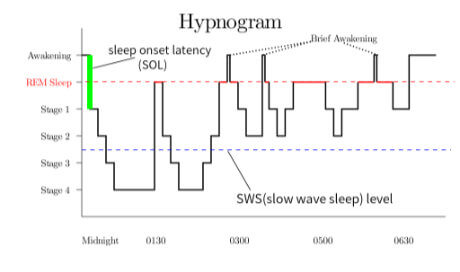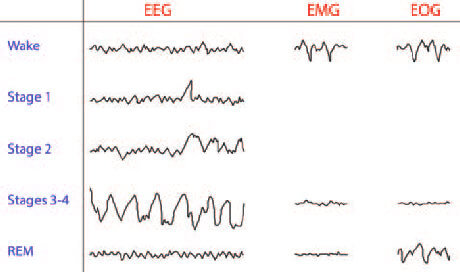This post is part of a larger deep dive
Curious about the role of the sleep stages and their role in dreaming, the meaning of dreams and lucid dreaming in Paprika? Check out Paprika Explained!
Or read the full Paprika article!
This post is part of a larger deep dive
Curious about the role of the sleep stages and their role in dreaming, the meaning of dreams and lucid dreaming in Paprika? Check out Paprika Explained!
Or read the full Paprika article!

When talking about dreams, it is inevitable to mention sleeping.
During the usual 7/8 hours sleep each night, humans cycle between two types of sleep every 90 minutes or so: REM (Rapid Eye Movement) and NREM (non Rapid Eye Movement) sleep.


NREM sleep is, in fact, divided into three distinct stages: N1, N2 and N3 (there is also an N4 but it is usually grouped with N3).
N1 is the lightest stage of sleep, so it’s very easy to wake up from. It is also the shortest, lasting only a few minutes as soon as you fall asleep, which can happen three or four times throughout the night. As such, N1 sleep is more of a transition stage between wake and sleep. The body has not yet fully relaxed, and brain activity only slows down slightly. One of its functions may be to tag current concerns or memories for later deeper sleep processing. N1 accounts for only about 5% of the entire sleep cycle.
During N2, heart rate and body temperature start to drop and muscles relax; breathing and brain activity also slow down. N2 sleep appears critical for the establishment of motor skill learning — automatic skills that do not require conscious awareness. Studies have shown that a healthy dose of N2 sleep helps people consolidate newly acquired motor sequences (e.g., finger tapping) that had been learnt the day before.
N3 follows N2 sleep and it is the deepest stage of sleep. It is colloquially referred to as slow-wave sleep, due to the larger (slower) brain waves. The “slowness” of N3 waves (called delta waves) are due to thousands and thousands of neurons all firing synchronously every two or three times per second. Muscle tone, heart rate and breathing rate continue to decrease as the body enters deep sleep; eye movements also come to a halt.
In general, N3 sleep is believed to be the phase when your brain is cherry-picking which memories to weed out and which are worth keeping. It also strengthens those important memories by transferring them from volatile storage sites in the brain into more permanent ones.
Additionally, it is during N3 sleep that important functions of neural sanitation mostly take place. When neurons do their work they produce dangerous by-products. It is during N3 sleep, that these contaminants are washed away by a fluid that bathes the entire brain (the cerebrospinal fluid).
N3 occurs mostly during the first half of the night, and can vanish completely in the second half, where it is gradually replaced by REM sleep.
If you look at the electrical brain activity during REM sleep you will immediately recognise that it is almost indistinguishable from waking electrical brain activity. In fact, it is so similar that researchers need to monitor muscle tone to be able to differentiate the two (compare the EMG readouts between wake and REM in the figure above).
With NREM the deeper the sleep is, the more relaxed your body is. By the time you reach REM your ability to control your muscles is completely lost — you are effectively paralysed!
And that is not a bad thing.
Atonia, as this temporary paralysis is called, is caused by the brain sending signals to pretty much every portion of your spinal chord, instructing it to shut down momentarily. Exceptions to this rule are the muscles of the diaphragm, which control your breathing, as well as the muscles of the eyes, which dart around inside the closed eyelids, and, incidentally, the reason why we refer to this type of sleep as Rapid Eye Movement (REM) sleep.
As a result of this general stand-by, the muscles of your legs and arms are disabled, which prevents you from inadvertently kicking and punching your partner in your sleep.
Although we cycle in and out of REM every 90 minutes, the duration of REM sleep increases with each cycle.
The benefits of REM sleep are plentiful. For example, it regulates emotions, facilitates accurate recognition and comprehension, fuels problem solving and creativity, plays a crucial role in language learning during childhood, and tunes the ability to discern subtle emotional facial expressions.

People tend to associate dreams with REM sleep, but it is not true that we only dream during this stage. In fact, we dream throughout the entire night.
Researchers estimate dreaming by waking participants up as soon as they enter a particular sleep stage.
It is believed that about 75% of N1, 70% of N2 and 50% of N3 awakenings result in a dreaming report. For REM awakenings that number goes up to 80%.
N1 dreams are very short in duration (people don’t spend much time in this stage anyway), less emotional and less bizarre than late-night dreams. They most often relate to thoughts you are having shortly before you slumber. Hypnagogic dreams (dreams that take place during the transition from wake to sleep) occur during this sleep stage, and it as been suggested that it is N1 dreams that assist in problem-solving and creativity.
N2 and N3 dreams are longer than N1 dreams, and likely reflect associations of ongoing concerns the dreamer had just before falling asleep, with recent memories of the day.
REM dreams are probably what most people think of as a dream. They are longer, more emotional, more bizarre and have a much more complex narrative than dreams in any other sleep stage. The dreamer usually only observes dream events although it might occasionally interact with other dream characters.
There are, however, individuals who will be able to tell if they are dreaming or not, and a rarer portion of them are even capable of conjuring up objects and people at leisure (see the lucid dreaming section below).
One theory proposes that REM dreaming acts as a natural psychotherapy. Individuals with anxiety or depression that REM-dreamed about their painful waking experiences had a significantly higher recovery rate than those patients who dreamed about unrelated experiences. This has led researchers to argue that one of the functions of REM dreaming is to regulate negative emotions.

Based on your own dreaming experiences, you might believe that dreams are always bizarre and incoherent. However, this is not the case.
In fact, research suggests that only about 10-20% of dream reports contain more than two forms of bizarreness, such as a scene transformation or an incongruity.
NREM dreams also tend to be considerably less bizarre than REM dreams, and about 1/4 of REM dreams contain no bizarreness at all.
Furthermore, truly weird REM dreams only seem to appear later at night, and are often more emotionally intense and longer in duration.
Thus, due to their more recent occurrence, being more distinct, more emotional and longer, REM late-night dreams become easier to encode into memory, increasing the likelihood that we will remember them when we wake up.
Also, it’s not as if “anything goes” in the dream world. Even the bizarreness of dreams appears to have certain “rules”. For example, items that suffer a transformation inside the dream usually keep its class (objects tend to transform into other objects, people into other people, vehicles into other vehicles, and so on). There is rarely a dream in which an object transformed into a person and vice versa.
Leave a comment
Add Your Recommendations
Popular Tags